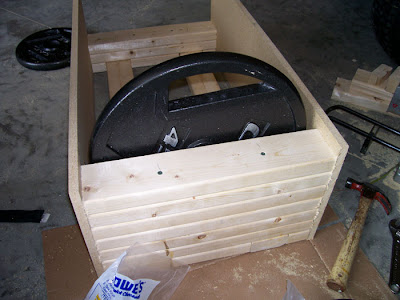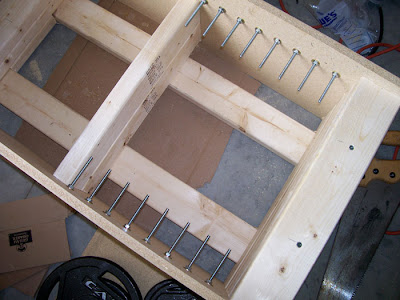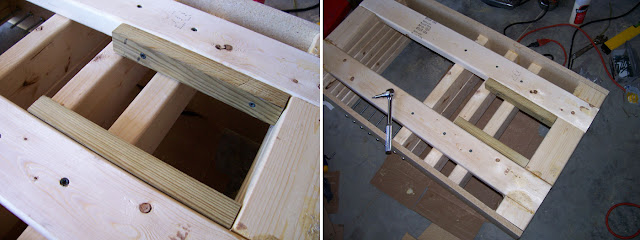Are your weights just lying around on the floor? This is unacceptable by Homemade Strength standards. Remedy the situation on your day off. It's cheap. It's easy. and it will make your gym that much more proper. This is an example of a project that doesn't have an exact commercial equivalent and it's still cheaper than similar commercial options.
Cost: about $35
Project time: 1 day
Difficulty: You have to cut wood using a saw or saws of your choice. You have to drill holes and drive screws into said wood. This is pretty basic stuff. Even a newb can learn this quickly so don't be scared. Man up.
Tools Needed:- Saw (for cutting wood) - miter saw is ideal for cutting your many 2 x 4s, but you'll also need something for long straight cuts in your particle board, like a normal hand saw, circular saw, or jigsaw.
- Drill / Screwdriver
- Sander - could be electric or just a hand rubber sanding block, and sand paper of course.
- Wrench - either a 1/4" or simply an adjustable one.
- Socket Wrench - in addition to a normal wrench, a socket wrench with the necessary pieces to accept a screwdriver bit will make one small part of the project much easier. Click here to see a picture of what I mean. (perhaps optional)
Materials Needed:- 2 x 4 studs (8 feet in length) - you need 4 of these.
- Particle Board (3/4 inch thick, 12 inches wide) - you need two pieces of 3 foot length each so you could buy a 6 foot long board or two 4 foot long boards, etc.
- 1" x 6" Wooden Board, typically used for a deck - you barely need any of this, 1 foot length. You could probably fashion these out of your leftover 2 x 4s if you want.
- Box of 2 and 1/2 inch deck screws - I like T25 star bit head screws
- 1/4" Carriage Bolts (3 and 1/2 inches long) - you need 16 of these. May be cheaper to just buy a bag of 20.
- 1/4" Nuts (to fit your carriage bolts) - obviously you need 16 of these as well.
- 5/16" Fender Washers - you need 16 of these. The size markings on washers tell you the inner diameter, just fyi. They have to be bigger than 1/4" because they must fit the square base of your carriage bolts, which is larger than the diameter of the threads.
- 1/4" Washers - you need 16 of these.
- Wood Glue
- Paint (optional)
- Pipe Insulation Foam (optional)
- Duct Tape / Electrical Tape (optional)
 |
| Plate "slots" can store 45 lb., 35 lb., and even spacer plates. |
What we're making today is a handy solution to organize our weight plates. I always see pictures of home gyms with stacks of plates just lying around on the ground. Let's tidy it up and make them conveniently accessible, shall we?
This project took me two days and that was with me making things up and designing as I worked. I got stumped and had to sleep on it to get past my sticking point in the design. I figure it could certainly be done, following instructions, in one day. But I'm an introverted worker. I take a lot of breaks and get lost in thought liberally throughout the project.
I used to have a commercial weight "tree" rack. Well, I technically still do have it. I should say I used to use a commercial weight rack. I didn't really like it. It was a cheaper one, at about $50. The problem is they aren't rated for a whole lot of weight and more importantly they don't have the space to accommodate enough big plates to add a whole lot of weight. The ones that are rated for serious poundages are near $100 in cost. I still don't know if they really have the space to stack up eight 45 lb. plates on them as well as all the essential smaller increments.
Because we're average guys in the garage, we probably won't be able to do serious metal fabrication. That's why wood is the material of choice for Homemade Strength. Given the nature of the material, it's more prudent for us to avoid the vertical frame design of normal metal plate racks. Instead, what we're going to do is mimic a horizontal plate rack design. No, this won't duplicate the function of portable platform racks, but it resembles that design more than the normal "tree" or "A frame" design.
Our custom DIY design will handle eight 45 lb. plates, as well as your quarters (2), dimes (2), nickles (5), and even your 2 1/2 lb. plates. This is a "full set" that when loaded on the bar would total 500 lbs. I think that's a solid figure. If you have 35 lb. plates they can be substituted at will for the 45 lb. plates; this rack will fit eight of either.
You can, of course, make your rack longer. The amount of plates it can hold is only limited by the length of the rack. All you have to do is make yours as long as you want it and you can load up as many 45 lb. plates as you choose. Mine is 3 feet long.
One last thing to get out of the way before we start. This is not a carrying case, nor a portable platform rack. Don't try to lift this thing and move it around with plates in it. I assure you the odds are it will break. It is perfectly strong when used properly. It is designed to store plates when sitting on the ground. The compressive strength of wood is great. If you lift it, now it's a matter of tensile strength and that's nowhere near as great. If you have to move it, unload the thing, then pick it up. The rack only weighs 45 lbs. itself so not a problem for anyone who trains with the weights this rack is designed to hold.
 |
| Weights, lacrosse balls, collars, bands, it's an equal opportunity storage device. |
Like most projects here on Homemade Strength, 2x4s play a significant role in its design. It's our favorite material because it's cheap and strong. It's designed for commercial framing purposes so it's perfect for our gym projects.
The first thing you have to do is decide how long you want your rack. The longer you make it, the more big plates (read that 45 lbs.) you can store. I made mine 36 inches (3 feet) long. If you choose differently, the key boards you'll have to make longer are the two initial 2 x 4 runners and the particle board sides. The rest will be the same for any size rack.
So, 36 inches is my chosen length. Measure and cut two pieces of 2x4 to this length. Now, Measure and cut two pieces of 2x4 to 7 inches long. These are our middle spacers. They will ensure the 2x4 runners are 7 inches apart. A miter saw is the fastest way to cut 2x4s but any saw that gets the job done, even a hand saw, will suffice. Now cut four pieces of 2x4, each one only 2 inches long.
 |
| Monkey see, monkey do. Not that I'm calling you a monkey or anything like that. |
The picture above shows how we are going to arrange all these pieces. lay your boards on the ground and dry fit them as shown. On each end you have a 2 inch piece, then the width of the long runner board, then the 7 inch piece, then the other runner board, then another 2 inch piece. Clearly a picture is far better than my sorry attempt at an explanation. Look and mimic.
You'll notice that if you measure the length of one of the ends of this frame, it will be roughly 18 inches. Whatever it is exactly, we now need to cut 8 pieces of 2 x 4 to this length. So measure and cut your boards until you have eight pieces that are 18 inches long each.
For the record, whenever you are cutting a long board into many smaller pieces you should always measure one, cut that one, then measure the next, and cut. Never mark many measurements off and then just go down the line cutting. The reason is, the saw blade will remove a significant amount of material and the boards will end up shorter than what you measured them to be. Measure, cut, measure, cut. That's how you do it.
 |
| Six on one side, two on the other. Do as I say, not as I photograph. |
Now take six of the newly cut 18 inch long boards and stack them up like pancakes on one end of your frame, as shown in the picture above. Not shown in the picture is that you should stack the other two on the other end of your frame. Two on one end, six on the other.
Alright. That was just a dry fit. Now we have to actually fasten it together. We're going to use the "glue and screw" method. Remove the eight boards that you stacked on the basic frame and put them aside. Put down some newspaper or spare cardboard from your recycling bin so you don't get glue all over your garage floor. You're going to slather wood glue on the sides of the boards you cut in the original step.
That is to say, the 7 inch boards, 1 inch boards and the long runners. Just put glue on the sides where these pieces touch each other and once again position them as I originally showed you. Whether you think it looks like part of a fence, a large "I", or a wide "H" I'll leave that to you.
As the diagram above shows, you're going to take one of the 18 inch pieces and put it back on top of the end of your now glued jigsaw puzzle of a frame. But before you do that, slather the bottom of it with glue, then smush it down like a sandwich with mayo on it. Take five of your deck screws and drive them through the top board, one into each of the five pieces on the bottom. Make sure all the ends are squared up and aligned before you do this.
Now, as the above diagram also shows, put another board on top of the one you just secured. Again slathering it with glue before you smush it down. This time only put two screws into it, towards the middle, using your eyes to determine where you can place them without jamming them into the five screws you just put in. Repeat this for the other side of your "H, I , fence post."
Now you have your frame, each end glued and screwed with two boards on top of it. Before we get to the other remaining pieces for one of the ends, we're going to put the sides on, to ensure that our stack of pancakes ends up stacked straight.
The sides, for now, are quite easy and simple. Either you bought one longer piece of particle board, or you bought two smaller (4 foot) pieces. Either way Make your cuts to create two pieces that are 3 feet in length (and 12 inches in width (height)); the same exact size as the long runners you first cut.
Position your sides up to the frame as shown above. We're going to pre-drill holes for our screws so choose a drill bit that is smaller than the threads of your deck screws. At this point there are only 2 boards stacked on each side, so your current top board is actually board number 2 in our stacks. Drill through the side of your particle board and into the side of the TOP board (#2) on each end of your frame. It has to be the this board. On the lower boards there are screws near the edge holding that mass of small pieces together.You can't screw into that mess because there are already too many screws there. So drill and then screw into the top board. Do this for all four corners of your box. One screw in each corner.
One end of this basic frame is done. Remember, "two on one side, six on the other." As of now, there is two on one side and two on the other. So one side is complete for now. The other needs four more pieces stacked up. The process is the same. Put your glue down, smush a piece of wood on top, and put your screws in to secure it. The diagram below will show that you're going to alternate between driving two screws and three screws. Follow the picture to coordinate your placement of screws.

Notice that you secure board 3 and 2 together with three screws (shown in red); one in the middle, two on the ends, to avoid the screws you've already put in. Then, when securing board 4 on top of 3 you use two screws (shown in blue). You alternate between using two and three screws each board you stack up. You'll end with two screws, which leaves you plenty of space in the sides of board 6 to secure your particle board side pieces into board 6; just like you did in board 2. I'm well aware of the fact that board 2 gets three screws in it from above (board 3). At that point, your side screws holding the particle board sides on will already be in board 2. Just be careful and use your senses to accommodate where you can and cannot put a screw. Sometimes detailed explanation just makes things sound difficult. I assure you this stuff is easy. Have confidence and just go with it.
Now we have the basic shape of our glorified box. As you can see in the picture, it's big enough to nicely house a 45 lb. plate. The end with your stack of six boards it the end which will hold your 45 lb. plates. Half of this box design will be delegated to this task. The other half, towards the "two stack" end will progressively step down from your quarters, to your dimes, and to your nickle plates.
 |
| LLLLLLLLLIKE A GLOVE! |
The next step is to section off the space for each of our big plates. I'm not completely sure if all normal iron plates are created equal, in terms of how thick they are. This would also work for bumper plates but they are so thick you'll have to make a rather long rack to accommodate them. So rather than tell you a measurement I'm going to recommend that you put one of your big 45 lb. plates up against the "six stack" of 2x4s. Set it straight up. Now take a pencil or pen and mark about 2 inches down from the top of your particle board and 1/4 inch away from the edge of the plate. This is going to be the space, the single slot, for one plate. You don't want it butt up against the plate because you're going to want a little bit of room to take your plates in and out.
Using a 1/4" drill bit, drill a hole on your mark, all the way through the particle board side. Before we continue, we're going to make a template out of paper so that we can duplicate this without having to measure for each slot. Grab a piece of paper and fold it over the top of the particle board side so that it covers the inside down to where you drilled the hole. Slide it all the way back so that its edge is against the six stack of 2x4s.
 |
| [sing] PATTERN POWER! (if you have young kids, you might get the joke.) |
Now use your pen to poke a hole in the paper where you drilled a hole in the particle board side. To mark your next hole, all you have to do is line up the back edge of the paper (the part that was against the six stack) with the front edge of the first hole you drilled. Pictures are very useful for explaining things. Use your pen or pencil to mark your next hole and repeat the procedure until you have a total of eight holes. Drill them out with your 1/4" bit.
That covers one side of your rack. To mark the other side, you can use the same template. You just have to use the opposite side. That is to say, the side that was facing you last time will now be against the particle board side. The top flap will have to be folded over the other way to sit along the top edge of your particle board. Again, mark eight holes and drill them out.
Take one of your carriage bolts, a 5/16 fender washer, a 1/4" washer and a nut. Put the 5/16" washer over the bolt, all the way to the head, then put the bolt through the particle board, then put on the 1/4 inch washer, and then finally the nut. Because the carriage bolt has a square shape under the head you'll have to hammer on it a bit to sink it into the hole. If you don't have a hammer, your wrench will do. If you don't have a wrench, then good luck properly tightening your bolts down.
If you intend to paint this rack then there's no need to put all the bolts in now, you'll only have to take them off to paint it properly. But eventually, when all is said and done you will put your bolts in this fashion for all the holes. When all is said and done you can opt to wrap your bolts in duct tape or electrical tape to soften them so you don't scratch your plates on them. This is optional.
The next step is to create the sections that will house our 25, 10, and 5 lb. plates. We're going to use 18" lengths of 2x4s. You're going to need 4 of them so mark and cut your wood. Unlike our "stacks" we're going to stand these up on their sides so that each one is "4 inches" tall. We're going to place the first of these just after the last hole you drilled. Put some glue on the sides of this piece where it will contact the particle board sides. Put it in position, then pre-drill your hole through the side of the particle board (remember to use the proper bit, not the 1/4" bit you were just using) and drive your screw in. Repeat for the other side. Now stack another of these 18" 2x4 pieces on top of the one you just put in. Repeat the same procedure.
 |
| Big plates and small plates don't get along. We have to put up a wall to avoid conflict. |
The easiest way to proceed is to take your two 25 lb. plates and stack them against your newly installed double 2x4 wall. Put the plates straight up and then lean them back just a tad so that they stay by themselves and not fall forward. Now you're going to do the same thing you just did for the last wall, except this time you're only using a single 2x4 piece, positioned right against the front edge of your 25 lb. plates. Glue and screw this piece in. Now you have your section for the 25 lb. plates done.
 |
| Using your plates to measure ensures perfection. |
There's is only one more board to put in. Just as you did with the 25 lb. plates, stack your two 10 lb. plates against the newly created single 2x4 wall. Stand them up straight by themselves so they don't fall over. Put your last 18 inch 2x4 piece along the front edge of your plates. Glue it and screw it, just as you've done several times before. This will give you the 10 lb. plate section, and what remains in front is your 5 lb. plate section.
The issue, however, is that neither the 10 lb. plates, nor the 5 lb. plates will fit properly between your bottom 2x4 runners. The gap between these is 7 inches and that does well for the bigger plates but is too much for the small plates. To remedy this, we are going to put smaller runner boards under the 10 and 5 lb. sections.
We want the gap between the boards under the 10 and 5 lb. plates to be five inches. The current space between the 2x4 runners is seven inches. So in order to keep our plates nice and center we need two boards of 1 inch width each. We want the boards to be as tall as the 2x4 runners and as long enough to span the 10 lb. and 5 lb. plate sections. In other words, about 9 1/2 inches long should do it.
I used a piece of 1x6 left over from my deck. You could likely fashion the piece from the scrap 2x4 pieces you have from this project. The dimensions of this board will be 1" wide, 1 and 1/2" tall, and 9 1/2 inches long. Now make two of these.

You're going to mount these (as shown above) under the sections that will hold your 10 and 5 lb. plates. Turn your entire rack over and work from the bottom. You'll attach your small runners by driving two screws through them into the side of your 2x4 runners. There is not a lot of space to work here. You won't be able to get a drill, nor a normal screwdriver. The way I remedied this was by using a socket wrench and a socket which allowed me to use a screwdriver bit. There are certainly other, more cumbersome ways of achieving the same result. But if you have a socket wrench, use it. If you don't have the right socket, I would imagine it's quite cheap.
As you can also see in the picture above, while you've got it turned over, put a screw into the bottom of each runner, through each of the three 2x4 "walls" you made to hold your smaller plates. So six screws total. This will just ensure that everything is nice and solid and interconnected.
Now we're going to make this thing a bit lighter and look a a little better by shaping the sides. As of right now they are just rectangles. As the picture below shows, we're going to cut the corner off at an angle. You can simply do this by eye as you see fit, after all, that's what I did. Or you can take my measurements. Working from the top corner of the "two stack" side, measure 6 and 7/16 inches down and mark it. Measure 17 and 1/16 inches across and mark it. Between these two points, draw a straight line. Cut along this line and then sand the edges to curve them. Do this with both sides.
You're almost done with the construction. There is only one step left, and you could argue that it's optional. You should have enough room in your 5 lb. plate section to fit a few 2 1/2 lb. plates as well. Rather than do this, I decided to do something different. What I did, can be seen below.
Simply take a scrap piece of 2x4. Use a 2 and 1/8 inch hole saw to cut through your board. The inside core is what we want. Sand this core down and place it on the rack as shown above. Use a 2 1/2 lb. plate to determine the proper position, so that a 2 1/2 lb. plate will fit on without interfering with the sides or the stack of 5 lb. plates. Then simply screw it down with a single deck screw through the center hole, which the hole saw already provided for you.
All that's left now is to paint it, if you choose. You can see I went with the same classic Doo-doo brown that I've used on all my projects here. There is one other additional thing you can do if you wish. You can pad the runners where your plates will sit with insulation foam if you wish to protect the wood.You can secure it down using tape, or any other way of your choosing.
And with that you're done.
- Carl











































